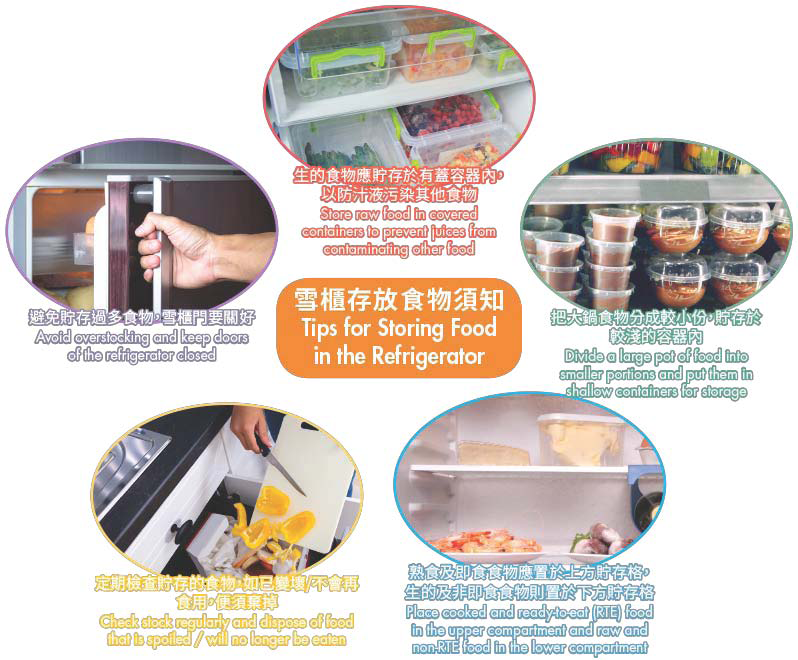
Food Safety Focus (165th Issue, April 2020) – Food Safety Platform
Home Cooking at the Time of a Pandemic
Reported by Mr. Kenneth YIP, Scientific Officer,
Risk Communication Section, Centre for Food Safety
In March 2020, the World Health Organization declared the novel coronavirus disease (COVID-19) outbreak as a pandemic. As advised to practise social distancing in order to reduce the spread of COVID-19, people are doing more home cooking instead of dining out these days. This article highlights the important points for home cooking to ensure food safety, especially at the time of a pandemic.
 Figure 3. Tips for storing food in the refrigerator.
Figure 3. Tips for storing food in the refrigerator.
Keeping Food Stock – Be Strategic
To meet the demand, some consumers may buy more to cater for a number of days’ needs. However, if food is not kept properly, it may lead to spoilage and wastage. Therefore, it is often a wise and economical practice to estimate and buy the quantity that is really needed, keep a running list of meals and their ingredients that your household already enjoys, and after purchasing, follow the storage instructions such as refrigeration or freezing. Refrigerated and frozen food should be stored at ≤4°C and ≤-18°C respectively. Figure 3 illustrates the tips for keeping food in the refrigerator to ensure proper storage. For food not requiring refrigeration, storage in a cool and dry place can help reduce fungal growth.
Follow Safe Food Handling Practices
Although it is unlikely that the novel coronavirus can be transmitted to human via food, the general rules of hygiene when preparing meals should beobserve. Hands should be washed before handling food and when contaminated by respiratory secretions, say, after coughing or sneezing. Wash hands by using liquid soap and water when hands are visibly dirty or soiled with body fluids. In addition, other food safety measures such as to handle raw and cooked food separately and to cook food thoroughly should be maintained.
Proper Handling of Excess Food and Leftovers
There may be leftovers when people cook more than they can eat. For convenience’s sake, some families may also make a big batch of food for later consumption. However, unfinished food is susceptible to spoilage and contamination if not being properly cooled and stored.
To prevent bacterial growth, it is important to cool food rapidly so it reaches as fast as possible a temperature fit for refrigeration. Food can be cooled quickly by slicing large pieces into smaller ones. Leftovers should be covered, wrapped in airtight packaging or sealed in storage containers. These practices help keep bacteria out, avoid cross-contamination, retain moisture and prevent leftovers from picking up odours from other food in the refrigerator. Most importantly, food should be refrigerated within two hours of finishing preparation, and food left at room temperature for more than four hours should be discarded.
One Step Forward – Reduce Dietary Sodium and Sugar
With more time spending at home, the opportunity to build a healthier eating habit by cooking our very own meals has never been so good. While too much sodium and sugar in food can increase the risk of chronic diseases, people can control the amount of salt and sugar added to their dishes through home cooking. Reading the nutrition labels on prepackaged food is also useful in knowing one's dietary intake of sodium and sugar.
Food safety is a prerequisite for a healthy diet, and ensuring the safety of food for consumption remains of utmost importance in trying times. While getting reacquainted with their home kitchens, the public should always observe the "Five Keys to Food Safety" to prevent foodborne diseases.


